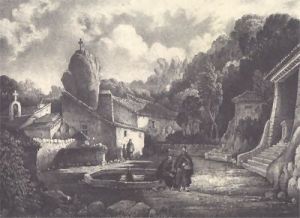A great writer once said that tragedy is presenting the destruction of something beautiful. Imagine the astonishment and disappointment Harold is experiencing as he was exploring Portugal. On the 30th of August, 1808, almost a year previous to either Childe Harold or Lord Byron's visit, the Convention of Sintra was signed to end the Peninsular War, an agreement that had been seen as a disgrace in the UK. Byron lamented more on the subject in a later stanza, but now as a first impression of the town, our hero is experiencing being awe-struck by the beauty and the horrid filth as a result of a nation's suffering.
 |
| The Gate of the Convent |
Egypt's plague, I'm not sure what it indicates; however, the 10 plagues of Egypt might just suggest the disasters that has been troubling the people here. Also one of the ten, the Plague of Locust, previously served as a metaphor of the French invaders.
Now we are finally introduced to the beautiful, glorious sight of Sintra that is hard for a painter to depict, or a poet to phrase. In a letter to his good friend Francis Hodgson, Byron called Sintra the most beautiful in the world. No wonder he compared it to Elysium. The letter and notes by Elysium: a mythological place for afterlife from Greek religions.
The letter I mentioned earlier was published in 1830 with notes by Thomas Moore (better known as Anacreon Moore), whom with John Murray, were responsible for burning Lord Byron's work after his death.
Letter 37, on Page 91 of Life, letters and journals of lord Byron, with notes, [by T. Moore].
By George Gordon N. Byron (6th baron.)
In front of us is a scene of mixed shades: a village of pristine beauty, a gift from nature as we see the serene water and elegant mountains; yet heavy from history and her spine bent from yesterday's suffering. We see a city that has just come to after having been spinning in the midst of disasters.
"Our Lady's House of Woe", is actually the house of "Our Lady of Punishment". It's official name is Convento de Santa Cruz da Serra da Sintra(Convent of the Holy Cross of the Sintra Mountains). The Convent of the Capuchos (Convento dos Capuchos) might be one of the most famous sight in Sintra, and Byron wasn't the only Romantic poet who lamented on it. Friar Honorio (Honorius in the stanza), the best known one of the ten friars who lived there died in 1596 after dwelling in a grotto for 30 years. He was said to have lived to be 100 by then.
Some kind of a legend to be sure.






No comments:
Post a Comment